
On the night of January 23rd, 1961, a lucky turn of events prevented the greatest nuclear disaster the United States would have known. Thousands of people would have died instantly, with millions more at the mercy of nuclear fallout. This lucky save is now known as the Goldsboro Incident.
The Goldsboro incident wasn’t the only nuclear mishap that happened in the 1950s and 1960s, but it is definitely the one that could have had the most severe outcome. On that fateful night in January, a B-52 Stratofortress bomber patrolling the skies over the Atlantic Ocean developed a fuel leak. The pilots were advised to seer their craft and make an emergency landing at Seymour Johnson Air Force Base near Goldsboro, North Carolina. While approaching the airfield, the pilots lost control over the plane, and to save their own lives - had to bail out. Only five of the crew members managed to parachute safely out. Three pilots were killed in the crash.
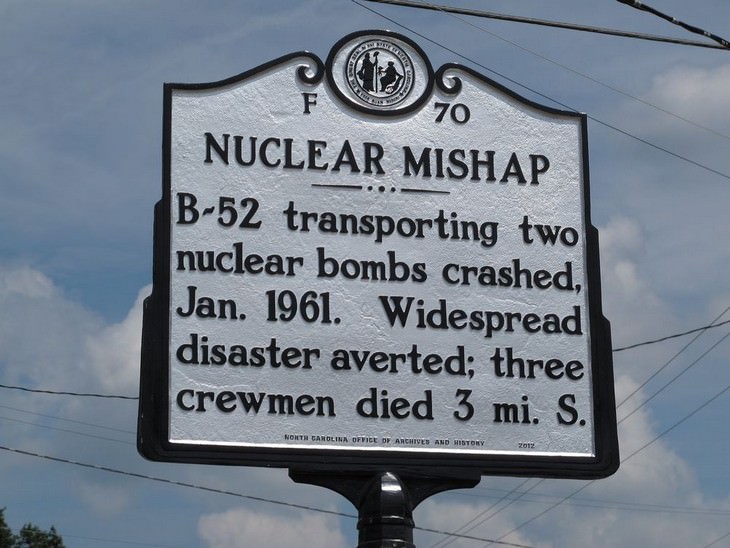

The official announcement of the US airforce claimed there was no danger of radiation in the area as the nuclear core of the weapons was intact. However, a former military analyst claimed to have seen highly classified documents that clarified how close the situation was to becoming complete chaos. According to said document, the bomb had accidentally armed itself while falling, and only one out of its seven arming switches was in the “off” position preventing detonation! This information was confirmed in 2013 by author Eric Schlosser. While researching his book Command and Control, Schlosser unearthed a declassified document written by the supervisor of the nuclear weapons safety department at Sandia National Laboratories Parker F Jones. “One simple, dynamo-technology, low voltage switch stood between the United States and a major catastrophe,” Jones wrote. The second weapon, which crashed without the parachute, broke up into several pieces, one of which was never found. The lost piece contained a significant amount of high-enriched uranium.
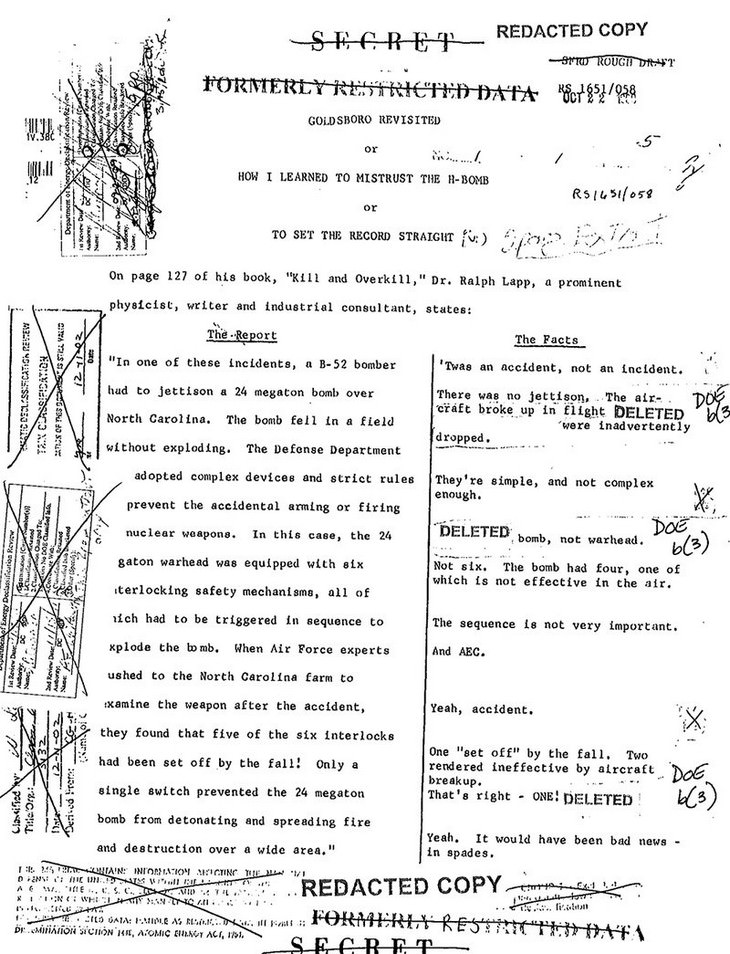
Had this one little switch not stayed on lock, the entire state of North Caroline might not have existed today. The fallen thermonuclear devices were 250 times more powerful than Little Boy, the bomb that was dropped on Hiroshima during WWII. If detonated, it would have produced a fireball 2 km in diameter and inflicted third-degree burns on anyone standing as far as 19 km away.
Some people disagree with this version of the incident, claiming the actual possibility of detonation was next to none. In their book Broken Arrow: The Declassified History of U.S. authors, Michael H. Maggelet and James C. Oskins point out that that the arm-ready switch was in the safe position, and the high-voltage battery was not activated, no electrical power could reach any components necessary to fire the weapon and produce a nuclear explosion.
Whatever the case may be, we should all be eternally grateful for the multiple safety systems that prevented the explosion, and most of all - to plain old luck.

QUIZ: What Do You Remember About the Cold War?
The Cold War (1947-1991) dominated the politics during most of our lives. So, looking back, how much do you remember about the war that brought us to the brink?
 9:37
9:37
The Surprising Origin of the Frozen TV Dinner
Frozen 'TV dinners' once dominated the American market. This is the surprising origins story of this popular food.
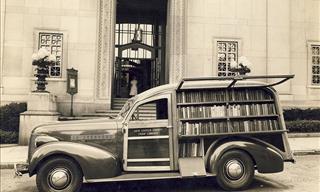
20 Nostalgic Images of Circulating Libraries
Way before Amazon, the visit of the bookmobile was one of the most exciting moments. These 20 nostalgic images capture the circulating libraries of the past.

QUIZ: Which Founding Father Were You in a Past Life?
Do you think you were the great George Washington, the confident Thomas Jefferson, or perhaps someone else? Take this personality quiz and find out!
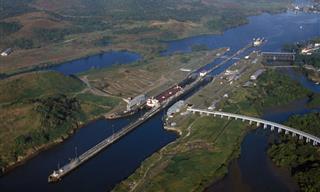
Panama Canal: Engineering Miracle with a Shocking History
You may not know it but the Panama Canal is one of the 20th century's greatest achievements. When you read its incredible history you will understand why.
 19:24
19:24
These Man Made Pools Provide Support to Millions of People
The Potash Ponds are not only a striking sight but also an extremely important resource. What's their story? Find out here.

These Photos Make Sure We Will Never Forget WW2
These photos document some of the moments of this epic yet haunting time in our history. I hope that future generations will not forget the lessons that war has taught us.

Archeologists Are Dumbfounded By These Discoveries
These archelogical sites have been proven to be difficult to explain.
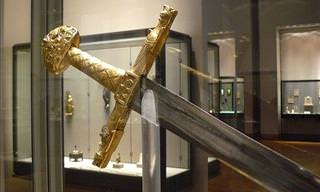
These Are the Most Famous Swords Ever Forged!
Check out 8 of the most legendary swords to have ever graced the field of battle!

Then & Now Photos Show How the World Has Changed
Here are some of the best pictures contributed by their users. Which impressed you most?

There is No Greater Blessing than Your Family
Beautiful Words: Having a family to care for is a blessing.

30 Essential Medical Terms For Bodily Functions
The next time you hear a doctor utter something in Latin, pay close attention, as after reading this article, you may understand what it means.

Do You Know The Origins of These Common Phrases?
There are many phrases that we use in English that we never give a second thought to. Here are 9 common phrases with rather sinister origins.
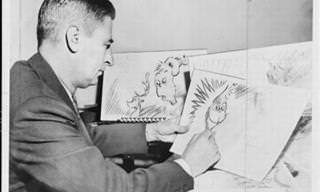
Travel History With These Amazing Photos of Yesteryear
Amazing photos reveal 150 years of history.
 7:11
7:11
This Is Why Skyscrapers Are So Rare in European Cities
High rise buildings are not very common in Europe, and history has everything to do with it...
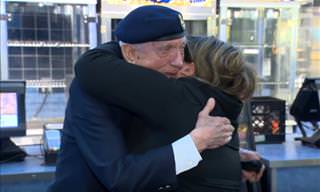 2:32
2:32
Watch: An Emotional Interview With a Dunkirk Veteran
At the premiere of the hit movie, Dunkirk, at Calgary’s Westhills Cinemas, theatergoers ended up having a surprise encounter with a 97-year-old veteran.
 12:47
12:47
Hitler and Stalin Weren’t the Only Evil Leaders in History
History has seen some truly cruel leaders. Let’s learn a little about some of the most ruthless ones.
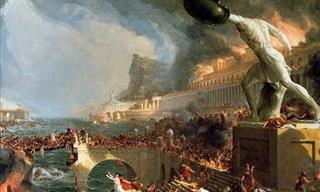 44:39
44:39
Full Documentary: The Fascinating History of the Dark Ages
Watch this fascinating documentary that sheds some great insight into how Rome fell, and what the Dark Ages actually consisted of.

Love is Beautifully Captured in These Historic Photos...
While much has changed over the last century, there is one thing that has always remained the same, and that is love. Take a look at this photo collection.

INTERACTIVE: 12 Fascinating Facts About Napoleon Bonaparte
Whether you're a history aficionado or a curious learner, these insights offer a unique glimpse into the man behind the legend of Napoleon.

Grandma Gets Asked a Question and Has a Perfect Response
When I asked grandma what she thought of events in recent years, I found her answer intriguing. It made me realize how much things have changed...

I Wish They Taught Me These Math Tips at School
Bad at math? Learn how to use these quick and easy methods.
 16:36
16:36
If You Like History You Will LOVE This Incredible Video!
Seeing history move right before our eyes teaches us so much about the last 2000 years!
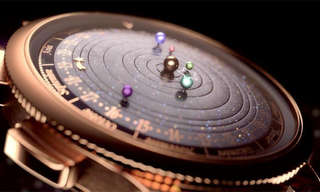
This May Be the Most Amazing Watch Ever Created...
Luxury watch makers Van Cleef & Arpels have created this dazzling creation, showing the planets and our sun while a small comet moves along a track to tell us the time.
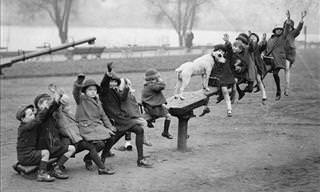
Do You Remember Playing Like These Photographed Children?
In the days before cellphones, the internet, and the like, we children had to learn how to make our fun. Remember playing like these retro kids?
 8:40
8:40
1 Day in Pompeii: Experience That Fateful Day!
One day in 79 AD the city of Pompeii was tragically destroyed by an extraordinary volcanic eruption. This video shows you just how the scene would have unfolded.
 4:20
4:20
WATCH: The Incredible Kindness of Strangers Is Wonderful
Strangers can be incredibly compassionate, and this is just as true when helping out an animal in distress. Watch this heart-warming video.
 17:06
17:06
Wow! Look at the Size of These Massive Fruits & Veggies!
These massive fruits and vegetables could feed you for an entire year!

9 Facts About Ancient Egypt You Probably Didn’t Know
Venture beyond the usual facts about the pyramids and Tutankhamen and learn 9 equally fascinating facts and misconceptions about Ancient Egypt
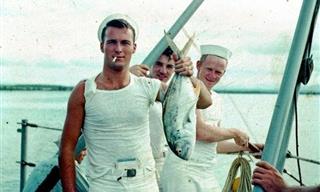
Nostalgia: Gorgeous Photos of America in the 1950s
We hope you enjoy these beautiful captures of the 1950s in the USA.

12 of the Most Fascinating Creatures in Norse Mythology
The world of Norse mythology is full of bizarre mythical creatures. Let’s take a look at the most fascinating ones.

14 Creepy Facts That Will Send Shivers Down Your Spine
These 14 surprising facts about the world may definitely send shivers down your spine, but they are still important to know and recognize!

These Theories On Reality Will Blow Your Mind
There are many crazy theories about the nature of reality, but some of them definitely outdo the others. Here are 10 mind-blowing theories about reality.
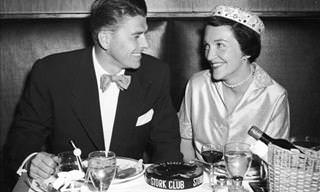
25 Photos That Capture Profound Historic Moments
We can see a whole century of monumental events go by in these photos...

13 People Who Proved that Age is Nothing But a Number
If you think that celebrating your golden jubilee means you're past your prime, then these 13 people have something to teach you...

Check Out These Rare and Fascinating Antonyms!
Here are a few rare but fascinating antonyms we wish people used more often.
 2:35
2:35
A Fascinating History of the New Year’s Eve
Did you know that New Year's hasn’t always been celebrated on January 1?
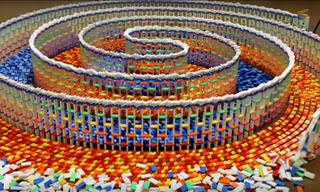 2:28
2:28
This Triple Spiral Domino Is Driving the Internet WILD!
Hevesh5 is a professional domino artist that is tearing the internet apart with this amazing display! I have never seen anything like this!

These Specialized Tools Have the Most Unique Uses
These specialized tools have the most unusual uses.
 8:13
8:13
You'd Never See THIS in a Modern Home
In this video, we'll visit some old homes and learn about their obsolete features.
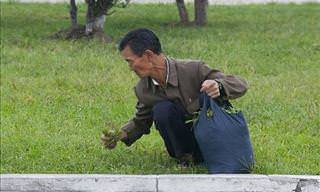
These Pictures Smuggled out of North Korea Will Shock You
Shocking photos that reveal what life really is like in North Korea.

It’s a Shame We Stopped Using These 17 Old English Words
These 17 old words are definitely missing in our modern vocabularies and deserve to be brought back into day-to-day speech
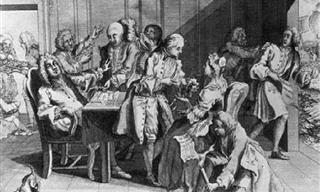
8 Little-Known Wars Rarely Found in History Books
Today, let’s talk about some of the weirdest and little-known wars from history.

Enrich Your Knowledge with These 18 Fascinating Facts!
Whether you love trivia, history, or just want to keep feeding your brain, these 18 facts will do for you.

You'd Best Think Twice Before Consuming These Delicacies!
Here are 10 dishes that can give you an adrenaline rush stronger than that from any roller-coaster, while testing your luck better than the lottery.

Mark Twain Really Had a Way With Words
These great quotes from Mark Twain are all-time classics, and worth remembering.

Believe These Myths to Be True? The Facts Are Surprising
Read through 11 common misconceptions, you've likely thought were facts.


